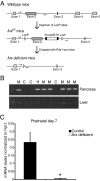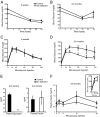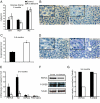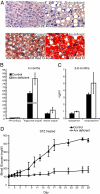Glucagon deficiency reduces hepatic glucose production and improves glucose tolerance in adult mice
- PMID: 20592160
- PMCID: PMC2940466
- DOI: 10.1210/me.2010-0120
Glucagon deficiency reduces hepatic glucose production and improves glucose tolerance in adult mice
Erratum in
- Mol Endocrinol. 2010 Oct;24(10):2072
Abstract
The major role of glucagon is to promote hepatic gluconeogenesis and glycogenolysis to raise blood glucose levels during hypoglycemic conditions. Several animal models have been established to examine the in vivo function of glucagon in the liver through attenuation of glucagon via glucagon receptor knockout animals and pharmacological interventions. To investigate the consequences of glucagon loss to hepatic glucose production and glucose homeostasis, we derived mice with a pancreas specific ablation of the alpha-cell transcription factor, Arx, resulting in a complete loss of the glucagon-producing pancreatic alpha-cell. Using this model, we found that glucagon is not required for the general health of mice but is essential for total hepatic glucose production. Our data clarifies the importance of glucagon during the regulation of fasting and postprandial glucose homeostasis.
Figures





References
-
- Unger RH 1971 Glucagon and the insulin: glucagon ratio in diabetes and other catabolic illnesses. Diabetes 20:834–838 - PubMed
-
- Burcelin R, Katz EB, Charron MJ 1996 Molecular and cellular aspects of the glucagon receptor: role in diabetes and metabolism. Diabetes Metab 22:373–396 - PubMed
-
- Toft I, Gerich JE, Jenssen T 2002 Autoregulation of endogenous glucose production during hyperglucagonemia. Metabolism 51:1128–1134 - PubMed
-
- Jiang G, Zhang B 2003 Glucagon and regulation of glucose metabolism. Am J Physiol Endocrinol Metab 284:671–678 - PubMed
-
- Consoli A 1992 Role of liver in pathophysiology of NIDDM. Diabetes Care 15:430–441 - PubMed
Publication types
MeSH terms
Substances
Grants and funding
LinkOut - more resources
Full Text Sources
Other Literature Sources
Medical
Molecular Biology Databases

